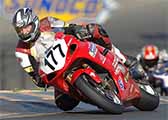 |
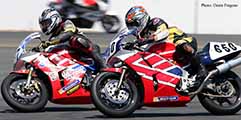 |
||||||||||||
|
G-Force Racing
Michael Lohmeyer |
|||||||||||||
|
|||||||||||||
 |
 |
||||||||||||
|
G-Force Racing
Michael Lohmeyer |
|||||||||||||
|
|||||||||||||
AFM Race Report - Buttonwillow Raceway
|
||||||||||||||||||||||||||||||||||||||||||||||||||||||||||||||||||||||||||||||||||||||||||||||
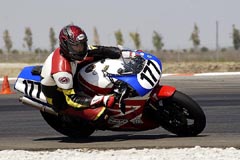 |
||
Contents:
Much of the carb work was to help Mike Norman with his VFR400, which he'll be racing all season, but also to help other VFR/RVF400 owners looking to improve their bike's power beyond stock carbs. It has long been held that the RVF400, when uncorked with a race exhaust, makes more power than the VFR400. But, there is much confusion on the Internet about which carbs are better. RLR Motorsports in the UK have found the NC30 carbs to work better, even on an RVF400. They should know as they have been very successful racing an RVF400 at the Isle of Mann, winning the event in 2003. It was nice to see my own tests confirm RLR's result, but it was also nice to see that NC35 carbs can be made to work almost as well as the NC30 carbs.
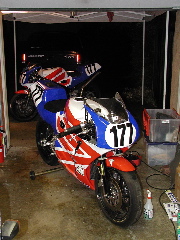 |
||
|
Both Bikes Ready to Go
|
||
The 450 rebuild was a different story. As I said, the NC35 engine seems to make more power than a similarly configured NC30 engine. For example, Mike Norman's stock NC35 engine, using my NC30 HRC carbs and a race exhaust makes about 70 HP with no internal engine mods. This is mostly due to a better ignition box (HRC ignition), different exhaust porting, and different cams compared to the NC30. All is not glossy with the NC35, though. The NC30 close ratio gearbox is better for racing, and as stated above, the NC30 carbs are better as well. I took the 450cc engine rebuild as an opportunity to put the best of everything in one engine.
Late last year, the 450cc engine's titanium rods let go on the dyno, punching a hole in the crank case and ruining other parts. I couldn't re-use that engine, so I bought a used NC35 motor for Mike to do the next 450cc engine. Mike built the new motor the same as the original, even using the NC30 gears from my original 450 motor, but this time we used steel rods from Carrillo. I used the NC30 gears because they are close ratio all the way down to 1st gear, whereas the NC35 gearing is more for street, with too much of a gap between 1st, 2nd, and 3rd gear. The resulting NC35 based 450cc motor makes the same power as the original NC30 motor, breaking our expectation of more power using the NC35 cams, exhaust porting, and HRC ignition box. As always, there's more Mike wants to try, though. We also found the cause to a nagging problem that has been robbing the engine of power, and may be the reason why the NC35 engine isn't showing any more power than the NC30 engine did. For now, the issue doesn't hurt anything except power, but we'll have to go back into the engine to fix it.
Why steel rods instead of titanium now? Mike sent the failed titanium rods to Carrillo for their input on why they failed. Carrillo pointed out the cause (poorly designed stress points), but also immediately offered to make new rods. Previously, Carrillo hadn't made rods for the NC30/35 motor (or any motor this small), which is part of why we didn't go with them in the first place. Now, they offered to make new steel rods, and alluded to the possibility of making titanium rods down the road.
With a couple weeks to spare, I got both new motors in their frames, broken in on the dyno, other work done, including putting the new NC35 carbs on the 400cc bike, and got to run both bikes at a track day even. For the first time, I had both bikes race worthy, including a set of carbs on the 400cc bike that were capable of finishing respectably in a race.
I went to Buttonwillow for Friday practice. I had been to BW about a month prior, but on a stock NC30 motor. I was eager to see how the new 450 motor would do. It makes a lot more torque than a stock motor, and that changes the drive I can get out of the corners. I started out the day on tires from last season. Though the old Michelin tires worked fine at previous track days on a stock motor, the 450's extra torque quickly overcame the old tires. After mounting new tires, everything was hooking up great, and by the end of the day, I was actually confidently spinning up the rear coming out of turn 2, something I had previously never done on a VFR400. I also had to learn a new way to go over the wheelie bump between turns 4 and 5. In the past, short shifting just before the bump was good enough to keep the front down. With the 450's torque, even a short shift didn't prevent the front tire from lofting for the sky. A shift in body position did the trick.
I also ran the 400cc engine a couple times on Friday. The fresh engine was a welcome change from the stock motor I ran all winter, and noticeably more powerful than the tired version I gave to Mike after the Sears race last year.
The last time I raced at BW, it was on the 400cc engine, just barely making it into the '57's with a 1:57.9. With the 450cc engine, I hoped to meet that lap time in practice, with the expectation of doing better during the races. Saturday, mid day, I met that, turning a 1:57.000 on the dBcom lap time sheet, much better than I hoped for during practice. I didn't ride the 400 enough to get comparable results, but I was in the sub-2:00 range on it as well.
During Sat. practice, I alternated between the 400cc and 450cc bikes, both to help break in the 400cc engine better (which had only minimal time on the new engine), and to better understand the differences in suspension and engine between the bikes. Switching bikes contributed to a mistake in the afternoon. I crashed exiting turn 1 on the 450. The cause? Getting on the gas too hard (duh!). I was riding the 450 like it was the 400. With the extra torque on the 450, the rear spun out and down I went. Later, I realized there is a patch of rough pavement exiting T1 as well, which was the other contributing factor. As I get closer to the limit, I guess I need to be more conscious of these factors. The result - I was fine, not even a bruise, but the bike was in bad shape. Both forks were bent (creased actually), and probably the triple clamps bent, the left exhaust pipe was crushed, rear set peg broken off, fairing stay bent, and the upper fairing broken along with the wind screen. So much for the new paint work I had done after last season's mishaps. I was done with practice for the rest of the day. I guess I shouldn't be too unhappy. Turn 1 is a fast corner, yet I just fell to the ground and slid to a stop on my back. The whole crash seemed to occur in slow motion, probably because it happened pretty slowly. It pays to stay relaxed during a crash.
Back in the pits, I had to clean the carbs out (the disadvantage of running without an air filter). Using carb cleaner, I took the carbs apart and sprayed everything out, including my eyes. Yes, like an idiot, I sprayed carb cleaner in my eyes (blow back from one of the carb's holes), and it was starting to hurt! In my mind, I pictured one of those nice eye wash stations that you find in chemistry labs - ya, that's what I need right now. All I could do was rush to my cooler, pull out one of my 1 gallon bottles of water and start washing out my eyes. The water immediately helped. My left eye was OK right away, but the right eye got a good helping of carb cleaner. After getting the worst of it washed out, I spent the next 10 minutes washing my eyes at the bathroom sinks. I think it's time to put eye protection in my tool kit.
Back to the bike. I put the carbs back on and everything ran fine. I took the crushed exhaust pipe to Mr. RPM, who cut the crushed section out of the pipe and welded a new piece in. It looks like a wart, but it was functional whereas the crushed pipe probably would have robbed the bike of some power.
As I said, the forks were kinked, and probably the triple clamps were bent. Thanks to my pit mates, David, Paul, Mike, Chris, and Mark for parts, assistance, eye drops, and head lights after the sun went down, we got the front ends swapped, a new rear set mounted, new clip on and other damage fixed. Sunday morning, I arrived early, finished up the work and made sure the bike was ready to go.
Sunday morning practice was cut short due to someone crashing, but I was able to get enough laps to confirm that the bike was handling fine. After almost two full days of practice, I didn't feel the need to ride any more than I had to. With my spare bike non-operational, I didn't want to push my luck either. Besides, Buttonwillow is an exhausting track. I was out of shape, so my body was telling me to take it easy. Conserving energy was more important than more practice at this point.
I was entered in 450 Superbike, the new Formula IV class, and Formula Pacific. Because Formula Pacific and Formula IV were back to back (FP first, then FIV), and because I didn't want to take any unnecessary risk, I removed myself from Formula Pacific. My main event, 450 Superbike was race #1, and Formula IV was race #9.
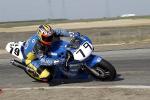 |
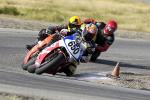 |
||||
|
Jose Quintanar, #79
|
Paul Yoshimune, #650
|
||||
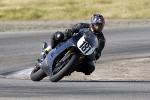 |
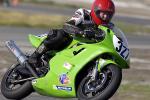 |
||||
|
Tim Wheeler, #181
|
Craig Sanders, #327
|
||||
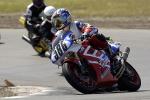 |
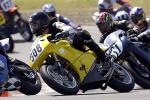 |
||||
|
Mike Norman, #586
|
Ian Gillies, #308
|
||||
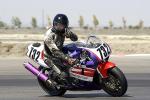 |
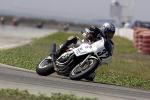 |
||||
|
Eddie Lee, #67
(on Denise Howard's CBR400RR) |
Ross Wells, #32
|
||||
|
© 2004 Gary Rather Photography
|
|||||
A side note, Eddie Lee bought Craig Sander's Production FZR400 on race day, and with no practice on the bike, rode it to second place in 450 Production. I'm not sure what Eddie plans to do for 450 SB, but he is setting a goal to go after Ross in 450 Production on Craig's old bike. It was great of Denise to loan him her CBR400RR for the 450 SB race as well.
For the first race weekend, gridding is based on overall points from last season. With Phil Douglas (3rd for 2003) and Richard Moore (4th for 2003) missing, the front row was gridded (from left to right), Ross Wells, myself, Eddie Lee, Robert Gardiner, and Dave Norgard. We were gridded as the second wave, behind open twins. Open twins got their 2, 1, and green flag, and after a short moment of thunder (gotta love those thumping twin coffee cans!), all that stood between me and the first turn was a long straight, and the wait for our own green flag. After what seems like several minutes, though it was only about 30 seconds, the 2 goes to a 1, sideways, and green flag. Finally the racing has begun.
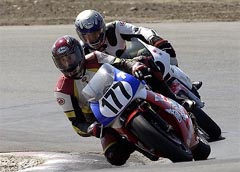 |
||
The restart was a repeat of the first time, though it was actually easier. Also, it was a 5 lap restart, instead of 6 laps. I was more relaxed, and that helped my arm as it didn't pump up at all during the race. By the time we passed start/finish at the end of the second lap, I was building a gap on Ross, and both of us were building a gap on the rest of the field. I reached the open twins back marker again, but this time had to pass him between turns 4 and 5. I crossed the finish line about 5 seconds ahead of Ross, and Ross was about 16 seconds ahead of 3rd place finisher, Tim Wheeler. Paul Yoshimune, with the other G-Force 450cc motor, ran in 3rd most the race, but Tim, who started at the back of the pack, was making a fast track for the front, passing Paul before the end. Eddie Lee took 5th on Denise Howard's Lippman CBR400RR. Not bad for riding someone else's bike, and having little practice on it.
My best time in the race was a 1:58.3 and Ross' was 2:00.5, neither of us riding at our best. I knew Ross was off the pace (he said so earlier in the day), but figured he would pull the speed out in the race. He did later on in the Formula IV race, turning 1:58's, but not soon enough to make a difference for the 450SB race.
After a long rest, I was ready to go for another race. My arm was still tired, but I hoped that I could stay relaxed during the race and keep it from pumping up.
Formula IV is a new AFM class for 2004. It is meant to bring the best of AFM's lightweight classes (250 SB, 450 SB, 500 Twins, 650 Twins, and open singles) together in a single class. The way the rules are written, other possible bike combinations are allowed. A 550cc limit is placed on 4 cylinder 4-stroke machines, which is a bike that isn't part of the other lightweight classes. The limit was set to allow FZR400 machines with 560cc engines (550 + 1mm) to complete in the class. This brought some controversy as Ross Wells said he had built a Yamaha R6 with a de-stroked crank, in order to meet the 550cc +1mm limit. The bike is legal according to the rules, but many people are unhappy with it because it completely breaks the mold of what was intended for the class. I've been told the bike makes 104 HP, which is about 15 more HP than anything else in the class. More power is likely possible with some tuning. The end result is a sub-class within the class - the de-tuned 600's, followed by everyone else. Given the reaction I've heard, it is likely some changes will occur for Formula IV in 2005. In the mean time, we'll have to play it out as it is. Class intent aside, it is legal for 2004, and no one can fault Ross for that.
For Buttonwillow, however, Ross was unable to bring the new bike, as it broke a crank a couple weeks before the race. Too many re-welds on the crank, he said. I'm sorry for him that the crank broke. Such failures are expensive, and I don't wish an engine failure on anyone. I am glad that for at least one race, though, we got to run the event as it was intended.
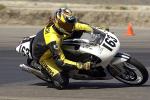 |
||
Since Formula IV is a new class, gridding was a bit of a question mark. When the grid sheet came out, it was by overall AFM points from 2003. That put Ross Wells (#32, 5th overall for 2003) on the pole, with me (6th overall for 2003) next to him. To my right was ??? (I can't remember), then Jove Shapiro (#57, 2003 250 SB champion, 2003 9th overall), and Kurt Spencer (#106, 2003 650 Twins champion, 2003 17th overall). Most of the top players in 650 Twins, 450 SB, and 250 SB were within the front three rows, but several other top riders where much further back, such as Brian Long (#71, SV650 rider, and multi-time CCS West Region #1 plate holder), Ben Welch (#163), and others. There were 60 people on the grid, and we were gridded as the first wave, with the Super Dinosaur class (3 riders) behind us.
Well, enough about the class. How did the racing go?
I was more relaxed for FIV than I was for 450 SB earlier in the day. Since I had no expectations for the class, there wasn't anything to get stressed about. I looked behind me at the grid, and all I saw was bikes all the way to the horizon. I knew I better now blow this start, or these guys would eat me alive.
With a 2, 1, sideways and green flag, we were off. Both Ross and I got poor starts, with what seemed like most the second row coming past us. I ended up behind Ross, and had to do a brake check behind him as he slowed for the crowd going through turn 1. Kurt Specer got the hole shot and led for the better part of the first lap. I knew if I didn't get with the front pack immediately, there would be no chance for a podium spot. I made every opportunity count, passing on the outside between turns 1 and 2, into the entrance of turn 2, and out braking someone into turn 3. By the end of the first lap, I was in 3rd, behind Jason Butler (2nd) and Felipe Cabezas (1st). Brian Long must have been close behind, because it wasn't long before he got around me. (Note, I have made corrections: I realized it was Felipe, not Kurt, that was in the lead after the first lap. Sorry for the confusion.)
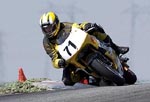 |
|||
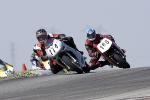 |
||
|
Felipe Cabezas, #774, Formula IV 3rd place, being chased by Jason Butler, #166
© 2004 Gary Rather Photography |
||
Brian was 1st, with me a close second. Felipe Cabezas finished 3rd, about 7 seconds behind us, but with Jason Butler (4th) hot on his heels. Michael Metcalf finished 5th. Four SV650's, with my VFR400 in the middle. Ross Wells finished 6th, pulling the 1:58 lap times he needed in 450SB, then Kurt Spencer followed by Ben Welch in 8th. The top 8 riders were all below 2 minutes a lap (for their best lap times), and Ben Welch was on the move on his 426cc single in a 125 GP chassis, the only other rider to get a 1:57. Given more time, or a better starting position, Ben would likely have moved further up the grid, or been dicing with Brian and I.
This first race at Buttonwillow was a good start... a good proof of theory. At the next race, though (Infinion Raceway at Sears Point), things will be a little tougher. Horsepower matters less at Sears compared to corner speed. Welch's little 125 framed single may be the bike to beat. Now that most the players are gridded closely together, the competition in FIV should heat up. Regardless, 450 Superbike is still my main class, and Formula IV is mainly for fun. I'll continue to sign up for Formula Pacific as well (a class I enjoyed racing more than Formula I last year because people were a little more sane in FP), but with Formula IV replacing Formula I, I'm not sure it makes sense to push the limits in Formula Pacific anymore. We'll see.
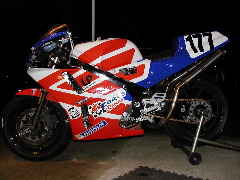 |
|
dBcom Results for selected classes (complete dBcom results available at http://www.unofficial-afm.com/results.html.
BARF (the Bay Area Rider's Forum) has made great plans to do a series of articles, video clips, interviews and more about AFM racing this year. Below is a sampling of some articles about the Buttonwillow race weekend. I am also including links to other press articles I find about the weekend. BARF's main race coverage can be found on their Racing page.
Last Updated:
Email me at: mike@akhara.com